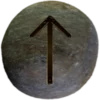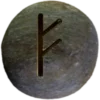Last Updated on February 24, 2025
Table of Contents
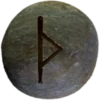
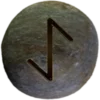
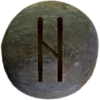
Origins and Meaning
Thurisaz (ᚦ), pronounced “THOO-ree-saz”, represents power, chaos, and conflict. It comes from the Proto-Germanic þurisaz, meaning “giant” or “thorn.” Other spellings include Thuris, Þurisaz, and Thurs. The Old Norse þurs (pronounced “thurs”) refers to the Jötnar, chaotic beings opposing the gods.
This rune embodies destructive and protective power. It symbolizes the primal force of storms, upheaval, and necessary struggle. The Poetic Edda and Prose Edda mention þursar (giants) as ancient beings from Ginnungagap. The Völuspá describes them as old enemies of the gods. The Hávamál warns against their trickery, showing their power to deceive. ![]()
Thurisaz represents the thorn’s dual nature. A thorn wounds but also protects. Warriors viewed this rune as a sign of strength in battle. It brings destruction and defense, forcing those who wield its power to act wisely.
This rune also connects to Thor. His role as a protector makes him the force that opposes the Jötnar. The Prose Edda describes Thor battling giants with Mjölnir, acting as the shield of the gods. His power mirrors Thurisaz, striking down enemies with controlled fury. ![]()
Symbolism and Uses
Thurisaz represents the raw force of nature and the will to overcome obstacles. Ancient warriors invoked it before battle. It symbolizes both external threats and internal struggles that test resilience.
Many cultures saw storms as the wrath of powerful beings. It connects to the raging tempest, symbolizing destruction and cleansing. Just as fire refines metal, struggle purifies the soul. Those who embrace Thurisaz must face their fears and emerge stronger.
This rune serves as a warning. It reminds those who use its power that unchecked force leads to ruin. A thorn protects the rose, but it can also wound the careless.
Runesmiths carved Thurisaz onto weapons and shields for protection. Some used it in defensive magic, believing it could repel harm. However, its energy is unpredictable, making it dangerous for those unprepared to wield it.
This rune also represents fate’s harsh lessons. Those who face hardship without retreating gain wisdom. Thurisaz shows that struggle leads to transformation. The Norse valued strength, but they also knew that reckless force brings downfall.
Runes Associated with Thurisaz
Eihwaz (ᛇ), pronounced “AY-waz”, represents transformation and resilience. Like Thurisaz, it deals with challenges, but Eihwaz focuses on growth through hardship. Both Elder Futhark runes push a person toward strength, though Eihwaz does so through endurance rather than force.
Hagalaz (ᚺ), pronounced “HA-ga-laz”, symbolizes disruption and necessary destruction. It brings sudden change, much like Thurisaz, but without a clear direction. Together, these runes remind a person that chaos and struggle shape destiny.
Its Power in Asatru
Strength defines a people. Without it, families, homes, and traditions fall. True power lies in standing firm and fighting when needed.
Thurisaz challenges Asatruar to embrace struggle. Hardship shapes those who refuse to surrender. It tests the will and forges warriors of heart and spirit.
Obstacles appear in every life. Facing them with courage builds wisdom. The thorn teaches caution, but it also urges action. With Thurisaz, an Asatruar meets fate head-on, unafraid of the storm.

